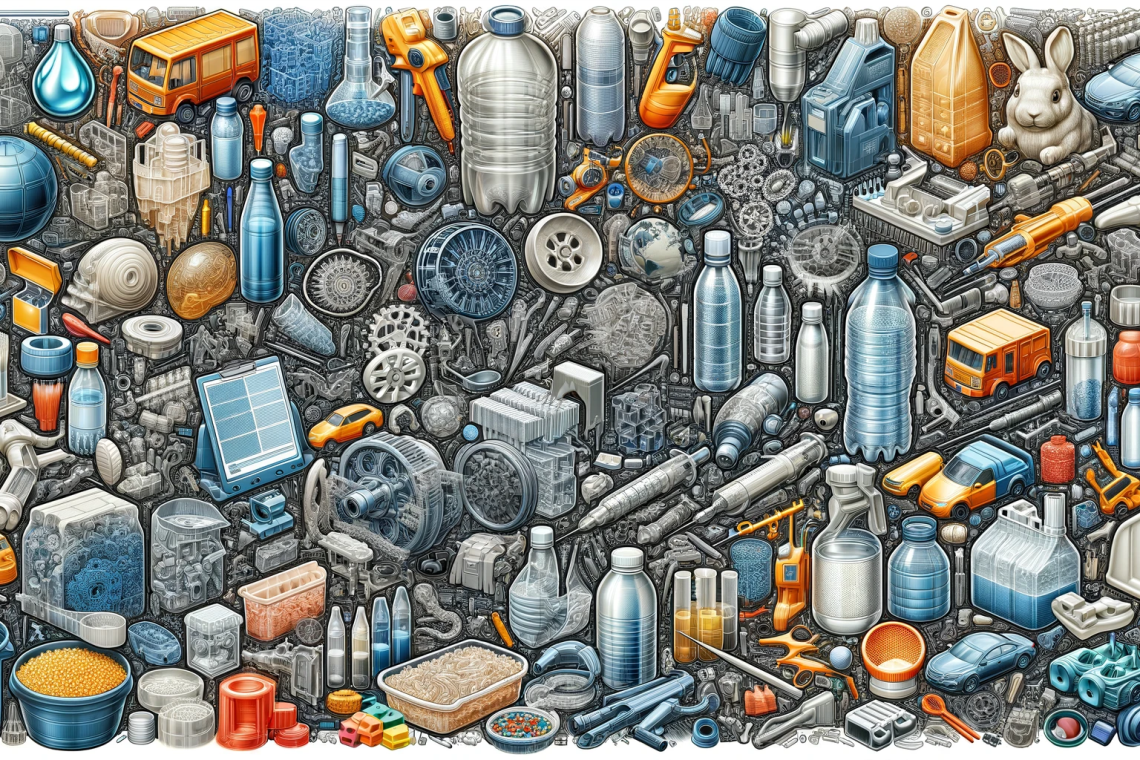Exploring the Expansive World of Plastics and Their Integral Role in Injection Moulding
In today’s world, plastics are incredibly versatile and can be found everywhere, even though we might not always notice them. They play a crucial role in shaping our daily lives, from the ordinary to the extraordinary. This post takes you on a journey into the world of plastics, highlighting their essential role in the art and science of injection moulding, with a special emphasis on choosing the right plastic for the job.
Acrylic (PMMA): The Clear Marvel
- Pros: Known for excellent clarity and UV resistance, good impact strength, and ease of colouring.
- Cons: Susceptible to stress cracking, sensitive to moisture during processing, and experiencing high shrinkage rates.
- Additives: UV stabilisers for outdoor applications, and impact modifiers to enhance strength.
- Overview: Acrylic, or Polymethyl Methacrylate, stands out for its crystal-clear appearance and robustness, finding use in vehicle parts and artistic installations, where its aesthetic appeal and functional resilience are key for the plastic choice for injection moulding.
Polycarbonate (PC): The Invisible Protector
- Pros: Offers exceptional strength, and heat resistance, and is as clear as glass.
- Cons: More expensive, prone to scratches, and may require drying before moulding.
- Additives: Scratch-resistant coatings and UV stabilisers for extended outdoor use.
- Overview: Polycarbonate is a go-to for applications demanding high precision and durability, such as in bulletproof windows and eyewear lenses, owing to its remarkable combination of transparency and strength, making it a crucial plastic choice for injection moulding.
Polyethylene (PE): The Versatile Family
- Pros: Comes in various densities, providing versatility; resistance to moisture and chemicals.
- Cons: Some forms can be less rigid and prone to warping.
- Additives: UV stabilisers for outdoor products, and antioxidants to prevent degradation.
- Overview: As the most common plastic, polyethene’s variations (LDPE, MDPE, HDPE, UHMWPE) serve diverse applications from sturdy bottles to flexible bags, showcasing its adaptability and importance in the plastic choice for injection moulding.
Polypropylene (PP): The Flexible Force
- Pros: Balances strength and flexibility; resistant to chemicals; does not break under stress.
- Cons: Has a high thermal expansion rate; can be difficult to paint or bond with adhesives.
- Additives: Stabilisers for UV resistance, and clarifying agents for transparency.
- Overview: Polypropylene, widely used in automotive parts and medical devices, stands out for its durability and flexibility, making it indispensable in various applications and an important plastic choice for injection moulding.
Polyethylene Terephthalate (PET): The Sturdy Transparent
- Pros: Excellent chemical resistance, high strength-to-weight ratio, and shatterproof.
- Cons: Sensitive to prolonged UV exposure, can degrade in hot and humid conditions.
- Additives: UV inhibitors and thermal stabilisers to enhance durability.
- Overview: PET, commonly used in food and liquid containers, combines clarity with resilience, making it a popular choice in packaging and textile fibres and an excellent plastic choice for injection moulding.
Polyvinyl Chloride (PVC): The Shape-Shifting Polymer
- Pros: Can be made rigid or flexible; good chemical and moisture resistance.
- Cons: Releases harmful toxins at high temperatures; not biodegradable.
- Additives: Plasticisers for flexibility, heat stabilisers, and impact modifiers.
- Overview: PVC’s versatility, used in everything from construction materials to medical tubing, stems from its ability to blend with other materials, allowing it to be tailored for a range of applications and a versatile plastic choice for injection moulding.
Acrylonitrile Butadiene Styrene (ABS): The Resilient Performer
- Pros: High impact resistance, glossy finish, and good machinability.
- Cons: Not very UV resistant; can warp with high temperatures.
- Additives: UV protectants for outdoor use, and flame retardants for safety.
- Overview: ABS is widely favoured in the automotive and refrigeration industries for its robustness and aesthetic appeal. It is evident in products like protective gear and toys, making it a popular plastic choice for injection moulding.
Polyvinylidene Chloride (PVDC): The Barrier Expert
- Pros: Excellent barrier against water, oxygen, and aromas; high chemical resistance.
- Cons: Difficult to recycle; can be more expensive than other plastics.
- Additives: Plasticisers for increased flexibility, and stabilisers for thermal resistance.
- Overview: PVDC excels in food packaging, helping to preserve freshness and extend shelf life, thanks to its superior barrier properties, marking it as an important plastic choice for injection moulding.
Polytetrafluoroethylene (PTFE): The Non-Stick Champion
- Pros: Non-stick surface, high heat resistance, and low friction coefficient.
- Cons: Complex processing requirements; not suitable for high-load applications.
- Additives: Fillers like glass fibre or carbon to enhance mechanical properties.
- Overview: Commonly known as Teflon, PTFE is indispensable in cookware and industrial parts due to its unique non-stick properties and resistance to high temperatures, being an innovative plastic choice for injection moulding.
Polylactic Acid (PLA): The Eco-Friendly Alternative
- Pros: Biodegradable, derived from renewable resources, good for low-temperature applications.
- Cons: Lower heat resistance, can deform under load, and has limited durability.
- Additives: Impact modifiers and plasticisers to improve flexibility and durability.
- Overview: PLA’s use in biodegradable products and medical implants highlights its eco-friendliness and suitability for sustainable applications, making it a forward-thinking plastic choice for injection moulding.
Unlock the Potential of Precision Plastics with Our Expert Injection Moulding Solutions
Polyurethane (PU): The Adaptable Material
- Pros: Versatile, durable, excellent abrasion and chemical resistance.
- Cons: Sensitive to moisture during processing, can degrade under UV light.
- Additives: UV inhibitors for outdoor applications, and flame retardants for safety.
- Overview: Polyurethane’s use ranges from foam seating to industrial coatings, owing to its adaptability and toughness in varied forms, making it a dynamic plastic choice for injection moulding.
polymethylpentene (PMP): The Laboratory Favourite
- Pros: High clarity, excellent chemical and heat resistance.
- Cons: Lower mechanical strength compared to other plastics; expensive.
- Additives: Reinforcing fibres for improved strength, and stabilisers for UV protection.
- Overview: PMP is crucial in laboratory equipment, especially where visual clarity and resistance to chemicals and heat are paramount, making it a specialised plastic choice for injection moulding.
Polyphenylene Oxide (PPO): The Industrial Backbone
- Pros: High mechanical strength, stable at high temperatures, and low moisture absorption.
- Cons: Can be difficult to process; relatively expensive.
- Additives: Flame retardants for safety and glass fibres for enhanced strength.
- Overview: PPO’s role in electronic components and automotive parts highlights its value for applications requiring stability under thermal stress, positioning it as a key plastic choice for injection moulding.
Polyamide (Nylon): The Durable All-Rounder
- Pros: Strong, resistant to heat and wear, versatile in applications.
- Cons: Absorbs moisture, which can affect dimensional stability; not UV resistant.
- Additives: UV stabilisers, flame retardants, and reinforcing fibres for improved properties.
- Overview: Nylon’s widespread use in textiles, automotive components, and consumer goods showcases its durability and adaptability, making it a key material in diverse industries and an essential plastic choice for injection moulding.
The Symphony of Plastics in Injection Moulding
Injection moulding is not just a manufacturing process; it’s a symphony where each plastic plays its unique part. As we delve deeper into this world, we encounter the science behind their melting points, the precision in their moulding, and the environmental narratives that guide their use. Plastic choice for injection moulding is crucial, not just for their physical properties but also for their ability to transform into objects that shape our daily lives. From the toughness of ABS in safety helmets to the flexibility of PU in car seats, each plastic has a story to tell in the realm of injection moulding.
In this narrative, plastics are not just materials; they are characters with roles, properties, and potentials. As we unravel the mysteries of plastic choice for injection moulding, we discover a world where science meets creativity, where materials are not just moulded but are given life to become integral parts of our world.



